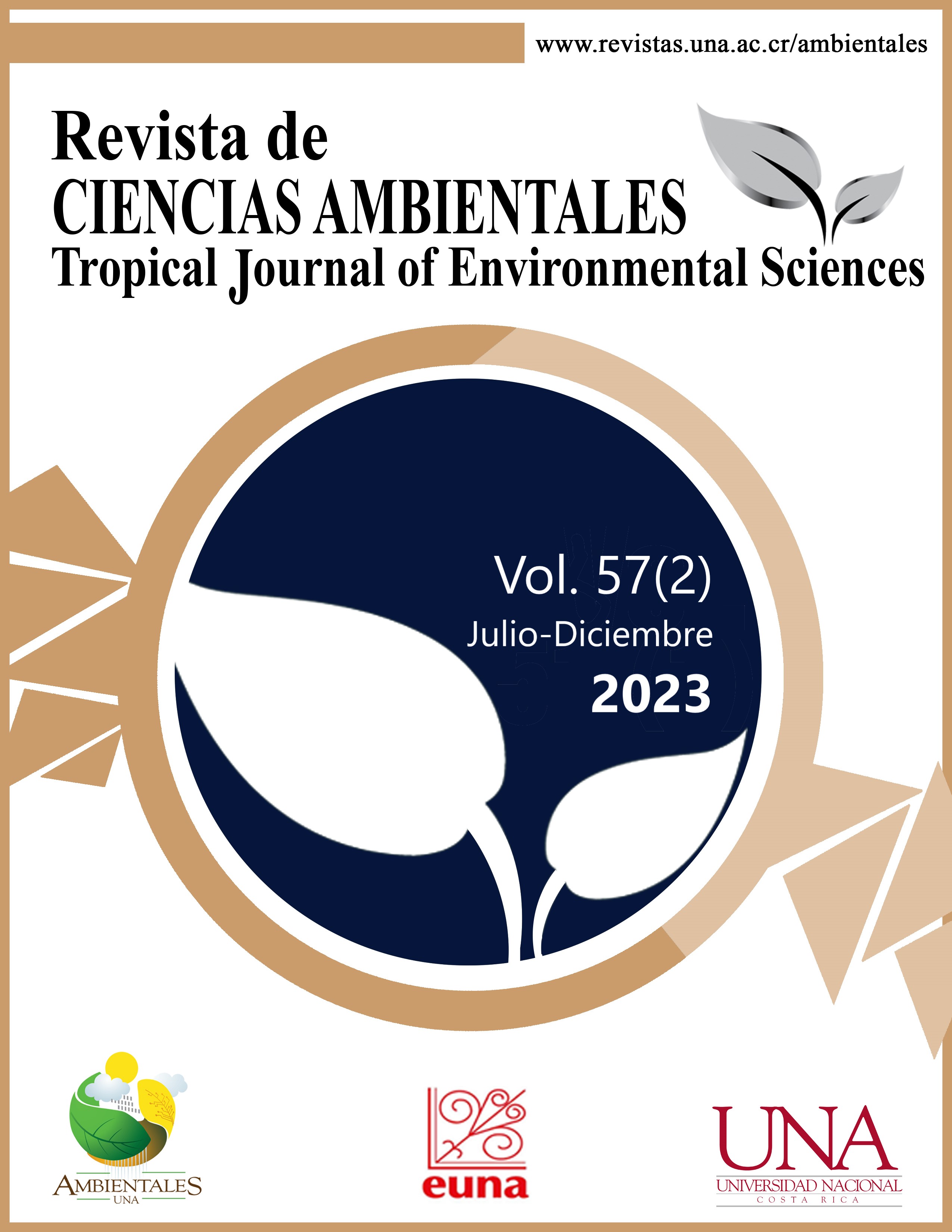Cambios en las moléculas de un crudo liviano sometido a un ensayo de meteorización en suelo para ser aplicado en geoquímica forense
DOI:
https://doi.org/10.15359/rca.57-2.8Palabras clave:
Esteranos;, fitano;, metildibenzotiofenos;, pristano;, terpanos.Resumen
[Introducción]: Cuando tiene lugar un vertido de crudo en el suelo comienza un proceso de meteorización que altera la composición de este recurso y en etapas avanzadas puede quedar irreconocible respecto al hidrocarburo original dificultando la asignación de responsabilidades asociadas a las contaminaciones de este tipo. [Objetivo]: En el presente trabajo se analizó la estabilidad de los n-alcanos, hidrocarburos aromáticos policíclicos e isoprenoides alifáticos en un crudo liviano sometido a un proceso de meteorización en suelo bajo condiciones de laboratorio por el período de un año, para ser aplicado en litigios vinculados a derrames y/o hurtos de hidrocarburos. [Metodología]: En base a esto, se analizaron los perfiles de las moléculas antes mencionadas por cromatografía gaseosa acoplada a espectrometría de masas a partir de las fracciones del crudo. [Resultados]: A continuación, se calcularon parámetros específicos tales como P/F (pristano/fitano), 4-MeDBT/1-MeDBT (metildibenzotiofenos) y estigmastano C29αS/hopano C30 conocidos como relaciones de diagnóstico que no superaron el 5 % de su desviación estándar relativa en el transcurso de un año. Por otro lado, las relaciones P/n-C17 (pristano/heptadecano), F/n-C18 (fitano/octadecano), (n-C13 + n-C14)/(n-C25 + n-C26) y (N0 + N1)/N2 (N = naftalenos) fueron las únicas con valores por encima del 5 %. [Conclusiones]: Estos resultados, más el análisis de los cromatogramas obtenidos, sugieren que tanto la evaporación como la biodegradación han alterado la composición general del crudo, no obstante, la mayoría de los isoprenoides permanecieron inalterados bajo las condiciones de ensayo a lo largo del tiempo de estudio lo que demuestra su capacidad para resolver las problemáticas descriptas.
Referencias
Abdulazeez, T. & Fantke, P. (2017). Polycyclic aromatic hydrocarbons. A review. Cogent Environmental Science, 3(1). https://doi.org/10.1080/23311843.2017.1339841
Acuña, A. & Pucci G. (2022). Domestication of an indigenous bacterial consortium to remove hydrocarbons from soils of the Austral Basin. International Journal of Science and Research, 11(5), 1898-1903.
Aeppli, C., Carmichael, C., Nelson, R., Lemkau, K., Graham, W., Redmond, M., Valentine, D. & Reddy, C. (2012). Oil Weathering after the Deepwater Horizon Disaster Led to the Formation of Oxygenated Residues. Environmental Science & Technology, 46(16), 8799-8807. https://doi.org/10.1021/es3015138
Aislabie, J., Balks, M., Astori, N., Stevenson, G. & Symons, R. (1999). Polycyclic aromatic hydrocarbons in fuel-oil contaminated soils. Antarctica, 39(13), 0-2207. https://doi.org/10.1016/S0045-6535(99)00144-7
An, T., Chen, H., Zhan, H., Zhu, Z. & Berndtsson, R. (2005). Sorption kinetics of naphthalene and phenantrene in loess soils. Environmental Geochemistry, 47(4), 467–474. https://doi.org/10.1007/s00254-004-1163-4
Brakstad, O., Daling, P., Faksness, L., Almas, I., Vang, S., Syslak, L. & Leirvik, F. (2014). Depletion and biodegradation of hydrocarbons in dispersions and emulsions of the Macondo 252 oil generated in an oil-on-seawater mesocosm flume basin. Marine Pollution Bulletin, 84(1-2), 125-134. https://doi.org/10.1016/j.marpolbul.2014.05.027
Brown, J., Beckmann, D., Bruce, L., Cook, L. & Mudge, S. (2011). PAH depletion ratios document the rapid weathering and attenuation of PAHs in oil samples collected after the Deepwater Horizon. In: Proceedings of the 2011 international oil spill conference. Portland, Oregon. https://doi.org/10.7901/2169-3358-2011-1-336
Douglas, G., Bence, A., Prince, E., Roger, C., Mc Millen, S. & Butler, E. (1996). Environmental Stability of Selected Petroleum Hydrocarbon Source and Weathering Ratios. Environmental Science & Technology, 30(7), 2332- https://doi.org/10.1021/es950751e
Douglas, G., Hardenstine, J., Liu, B. & Uhler, A. (2012). Laboratory and field verification of a method to estimate the extent of petroleum biodegradation in soil. Environmental Science Technology, 46(15), 8279-8287. https://doi.org/10.1021/es203976a
Faboya, O., Sojinu, S., Sonibare, O., Falodun, O. & Liao, Z. (2016). Aliphatic biomarkers distribution in crude oil-impacted soils: An environmental pollution indicator. Environmental Forensics, 17(1), 27-35. https://doi.org/10.1080/15275922.2015.1091400
Fernández-Varela, R., Andrade, J., Muniategui, S. & Prada, D. (2010). Selecting a reduced suite of diagnostic ratios calculated between petroleum biomarkers and polycyclic aromatic hydrocarbons to characterize a set of crude oils. Journal of Chromatography A, 1217, 8279-8289. https://doi.org/10.1016/j.chroma.2010.10.043
Greenwood, P., Wibrow, S., Suman, J. & Tibbett, M. (2008). Sequential hydrocarbon biodegradation in a soil from arid coastal Australia treated with oil under laboratory-controlled conditions. Organic Geochemistry, 39(9), 0-1346. https://doi.org/10.1016/j.orggeochem.2008.05.005
Kao, N., Su, M., Fan, J. & Chung, Y. (2015). Identification and quantification of biomarkers and polycyclic aromatic hydrocarbons (PAHs) in an aged mixed contaminated site: from source to soil. Environmental Science and Pollution Research, 22(10), 7529-7546. https://doi.org/10.1007/s11356-015-4237-9
Kienhuis, P., Kraus, U. & Kooistra K. (2019). Oil identification. En: Encyclopedia of Analytical Science. (Worsfold P., Townshend A., Poole C. y Miro M. Eds.). UK: Academic Press, pp. 45-52.
López, L. y Infante C. (2021). Cambios en los biomarcadores de la fracción de hidrocarburos saturados en un ensayo de biorremediación con un crudo extrapesado. Revista Internacional de Contaminación Ambiental, 37, 119-131. https://doi.org/10.20937/RICA.53718
Mariano, A., Kataoka, A., Angelis, D. & Bonotto, D. (2007). Laboratory study on the bioremediation of diesel oil contaminated soil from a petrol station. Brazilian Journal of Microbiology, 38, 346-353. https://doi.org/10.1590/S1517-83822007000200030
Munoz, D., Guiliano, M., Doumenq, P., Jacquot, F., Scherrer, P. & Mille, G. (1997). Long-term evolution of petroleum biomarkers in mangrove soil (Guadeloupe). Marine Pollution Bulletin, 34(11), 868-874. https://doi.org/10.1016/S0025-326X(97)00061-1
Olson, G., Gao, H., Meyer, B., Miles, M. & Overton, E. (2017). Effect of Corexit 9500 A on Mississippi Canyon crude oil weathering patterns using artificial and natural seawater. Heliyon, 3(3), e00269. https://doi.org/10.1016/j.heliyon.2017.e00269
Peters, K., Walters, C. & Moldowan, J. (2005). The Biomarker Guide. Biomarkers and Isotopes in the Environment and Human History Reino Unido: Cambridge University Press.
Prince, R., Garrett, R., Bare, R., Grosman, M., Townsend, T., Suflita, J., Lee, K., Owens, E., Sergy, G., Braddock, J., Lindstrom, J. & Lessard, R. (2003). The roles of photooxidation and biodegradation in long-term weathering of crude and heavy fuel oils. Spill Science Technology Bulletin, 8, 145-156. https://doi.org/10.1016/S1353-2561(03)00017-3
Rosell-Melé, A., Moraleda-Cibrián, N., Cartró-Sabaté, M., Colomer-Ventura, F., Mayor, P. & Orta-Martínez, M. (2018). Oil pollution in soils and sediments from the Northern Peruvian Amazon. Science of The Total Environment, 1010-1019. https://doi.org/10.1016/j.scitotenv.2017.07.208
Seguel, C., Mudge, S., Salgado, C. & Toledo, M. (2001). Tracing sewage in the marine environment: Altered signatures in Concepcion Bay, Chile. Water Research, 17, 4166-4174. https://doi.org/10.1016/S0043-1354(01)00146-4
Service, C., Nelson, T., Paquet, P., Mclnes, W., Chris, T. & Service, C. (2012). Pipelines and parks: evaluating external risks to protected areas from the proposed Northern Gateway Oil Transport Project. Natural Areas Journal, 32, 367-376. https://doi.org/10.3375/043.032.0404
Sutton, P., Lewis, C. & Rowland, S. (2005). Isolation of individual hydrocarbons from the unresolved complex hydrocarbon mixture of a biodegraded crude oil using preparative capillary gas chromatography. Organic Geochemistry, 36, 963-970. https://doi.org/10.1016/j.orggeochem.2004.11.007
Toledo, S., Peri, P. & Fontenla, S. (2022). Environmental Conditions and Grazing Exerted Effects on Arbuscular Mycorrhizal in Plants at Southern Patagonia Rangelands. Rangeland Ecology & Management, 81, 44-54. https://doi.org/10.1016/j.rama.2021.11.005
Tomas, G. y Acuña, A. (2023). Estudio de biomarcadores del petróleo a partir de la meteorización de un crudo en agua de mar. Revista Internacional de Contaminación Ambiental, 39, 71-84. https://doi.org/10.20937/RICA.54799
Tomas, G. y Acuña, A. (2022). Biomarcadores aplicados al estudio de crudos extraídos de la Formación Magallanes, Cuenca Austral, Argentina. Boletín de la Sociedad Geológica Mexicana, 74(1), A160621. https://doi.org/10.18268/BSGM2022v74n1a160621
Wang, Z. & Fingas, M. (2003). Development of oil hydrocarbon fingerprinting and identification techniques. Marine Pollution Bulletin, 47(9-12), 423-452. https://doi.org/10.1016/S0025-326X(03)00215-7
Wang, Z., Stout, S. & Fingas, M. (2006). Forensic fingerprinting of biomarkers for oil spill characterization and source identification. Environmental Forensics, 7, 105-146. https://doi.org/10.1080/15275920600667104
Yavari, S., Malakahmad, A. & Sapari, N. (2015). A review on phytoremediation of crude oil spills. Water, Air, and Soil Pollution, 226(8). https://doi.org/10.1007/s11270-015-2550-z
Yim, U., Ha, S., An, J., Won, J., Han, G., Hong, S., Kim, M., Jung, J. & Shim, W. (2011). Fingerprint and weathering characteristics of stranded oils after the Hebei Spirit oil spill. Journal of Hazardous Materials, 197, 60-69. https://doi.org/10.1016/j.jhazmat.2011.09.055
Zhang, H., Yin, X., Zhou, H., Wang, J. & Han, L. (2015). Weathering Characteristics of Crude Oils from Dalian Oil Spill Accident, China. Aquatic Procedia, 3, 238-244. https://doi.org/10.1016/j.aqpro.2015.02.217
Descargas
Publicado
Cómo citar
Número
Sección
Licencia
A partir del 17 de mayo del 2018 la licencia ha sido actualizada a:

Esta obra está bajo una Licencia Creative Commons Atribución-NoComercial-CompartirIgual 4.0 Internacional.



















